Two months ago I blogged about virus data, and noted that a “natural experiment” was happening in Scandinavia, where Sweden was trying a strategy of herd immunity. It appears to be a complete failure.
The idea was that herd immunity would cause the number of new COVID-19 cases to decline, without the shutdown policies and economic impact adopted by its Scandinavian neighbors. But the rate of new cases in Sweden hasn’t declined, while its neighbors’ all have:
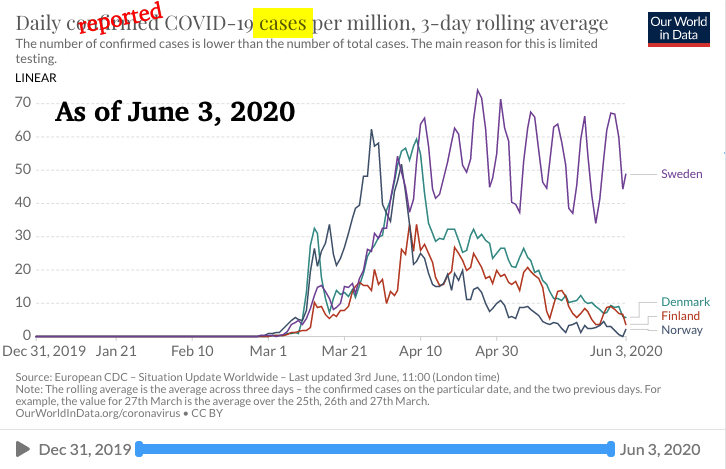
I blogged May 4 about the herd immunity strategy and how it tends to be a disaster if you don’t have a vaccine. The idea is that you let a disease run through a “herd” (animals or people) and eventually enough die or become immune that those who remain don’t transmit the disease much.
The chief Swedish epidemiologist said in April that he expected Sweden to get there in May. Here’s a summary of headlines since then:
- 4/21: Sweden’s ‘trust-based’ approach to tackling the pandemic in Nature
- 4/28: Tegnell says ‘herd immunity’ in Sweden might be a few weeks away (USA Today)
- 5/7: Architect of Sweden’s no-lockdown strategy insists it will pay off (Financial Times)
- 5/20: Swedish antibody study shows little sign of herd immunity (San Jose Mercury News)
- 5/25: Stockholm Won’t Reach Herd Immunity In May (NPR)
- 5/29: Sweden snubbed as Norway and Denmark open borders (Financial Times)
- 6/3: We should have done more, admits architect of Sweden’s Covid-19 strategy (The Guardian)
But that same day, Swedish friend Peter Carstedt said on FB, “His position remains that Sweden has not chosen the wrong strategy, but that there are lessons to be learnt” – nobody knew that nursing homes would be so contagious, they should have tested there more aggressively, etc. So it’ll be interesting to see in a few weeks if this realization produces improvement.
Surprisingly, a couple of days later a big spike in case count arose: Swedish friend Maria Hägglund says a big private lab had forgotten to report its results to the government(!!). So there had actually been thousands more cases than reported, which all got shoved into the reports at once. So as of today the graph at top looks like this – oy:
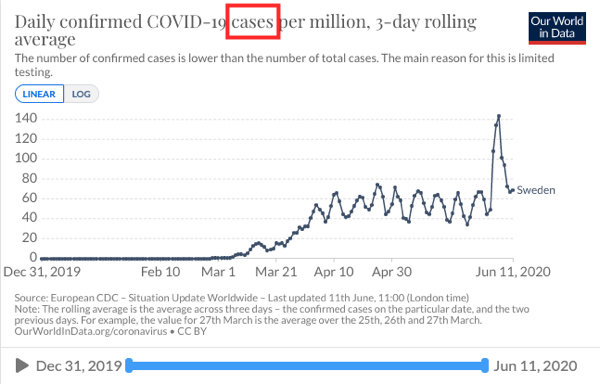
Then yesterday, the ultimate happened, which may sound familiar to Americans: Sweden to drop daily coronavirus briefings (Fortune). (They’ll report twice a week, not daily.)
By the way: this data isn’t granular enough.
It seems likely that for a long time (years?) we’ll have rolling outbreaks (as we’re seeing today in Texas and Arizona), and as life tries to return to the new normal, we’ll need to learn to dodge them. How?
I still worry that numbers like the above – reported cases and deaths for a whole country – are not granular enough (not detailed enough) for us as individuals to make decisions on our situations. I long for a breakdown of any country or state’s data into three categories:
- Problem areas where cases are raging (as was the case in NY, Milan, London, Madrid … but never yet in Chicago, Copenhagen, etc)
- Specific hotspots, particularly densely packed places like nursing homes, prisons, whatever they might be at any moment.
- Everywhere else.
I say this because almost all of us live in “everywhere else,” which I suspect is a large part of why so many Americans won’t wear masks because they think there’s no problem, even as the US continues to have 25,000 new deaths a month. (Actually, 33,000 in the 31 days since May 11, but that may decline. Time will tell.)
There will be real, varying danger as outbreaks pop up like wildfires in different places, which may require re-lockdowns in place after place. But if we can figure out where lockdowns really aren’t solving much because case load is low – the “everywhere else” locales – perhaps we can get by with a semi-normal life using masks and sanitizer and distancing … at the cost of some sickness and death, which will surely continue in any case until vaccines and treatments come along.
To do that, we can’t settle for whole-country or whole-state numbers. We need to identify and isolate problems, to understand what “everywhere else” looks like too.
(Or, Americans could grow up and decide to follow mandates that benefit others, not just their selfish selves, as New Zealand did, to reach their current level of zero cases. They eliminated the virus. By obeying science-based rules.)
This is why I trust good science.
Speaking of science – this is all a damn good example of why it’s useful. It’s hard to get science right, and it has to be constantly re-examined and upgraded, but it’s just … useful for anticipating what approach might work. Or not work. And why: you gotta figure out the method, the why things happen or don’t. Without that it’s not science. And you end up asking “How was I supposed to know this would happen???” As you die, maybe.
When you meet someone who thinks science is BS, please point out gently (so they can hear it) that Arizona was one of the first states to reopen (May 15), and now four weeks later their cases are surging:
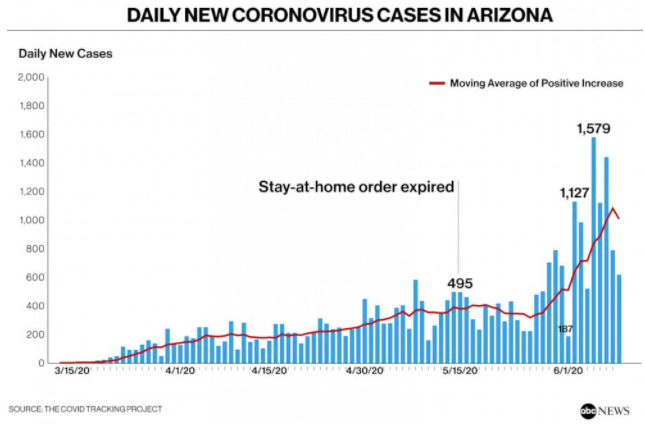
That’s from ABC News today, A pre-pandemic attitude toward social distancing may have led to the rebound. Who could ever have anticipated that?? I mean, the virus was in New York, and that’s so far away!
Well, it’s exactly parallel to what happened three months ago when the rest of Scandinavia locked down and Sweden didn’t: three weeks later they diverged. From an earlier post:
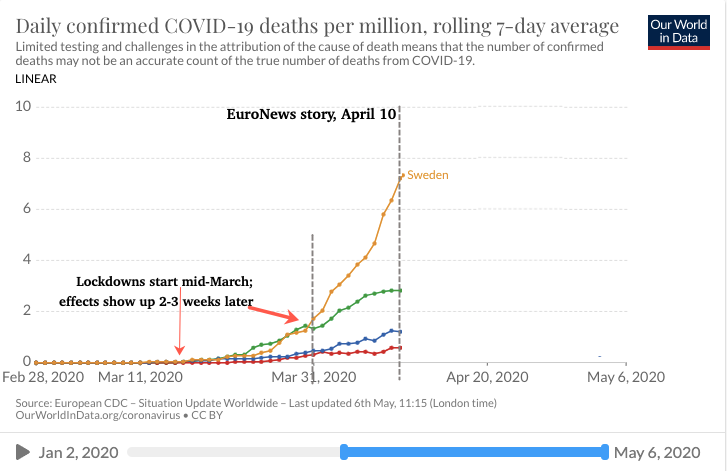
The attitude “we hardly have any cases around here, so we’re good” is exactly as bright as teens who say “We haven’t gotten pregnant yet, so I guess we don’t need rubbers anymore.” Both examples show a lack of understanding – a lack of scientific thinking.
A lot in life is uncertain but some things are predictable.
What can you do? Remember these recent posts:
- Re-opening into uncertainty, dangers, lessons and lies: what will *you* do?
- The next risk: sick people who can’t afford to stay home from work
- How universal masking minimizes COVID-19 risk (great graphic)
And from that re-opening post:
Use your head. Heed the science.
- Avoid contact, especially with irresponsible people.
- Update: Particularly avoid prolonged, close contact.
- Wear face coverings. Remember, it’s not just for you – it prevents spread [see the “universal masking” graphic below], and right now you don’t know whether you’re a symptomless carrier. (Wearing one sets an example for others, too.)
- Wash your damn hands when you come home or after touching stuff. It works! Stupid little soap bubbles deactivate the invisible virus!
- Be prepared to walk away from dangerous places and things.
Here’s that great graphic on masks, as a reminder.
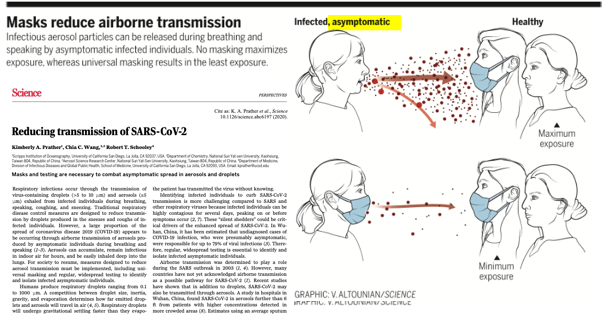



Great article Dave!
!t 1s a part1san art1cle l1ke most. All the po1nts about safe measures make general sense 1n spread of the v1rus. The data on d1stance, t1me of contact, crowd s1ze, and use of masks 1s severely lack1ng. Nobody really knows. However, most of 1t makes general sense.
Dave, however, 1s m1ss1ng the b1g po1nt. The larger p1cture … a very common th1ng to do. Nobody should care about the number of cases, unless that can overwhelm a hosp1tal system, such as early 1n a pandem1c, when we don’t have a publ1c awareness, and the flu peak 1s happen1ng.
But we can agree on the eventual number of deaths, and not just from COV1D, but from all causes. That 1s, 1f we agree to look at the b1g p1cture. Problem 1s, many do not or w1ll not or cannot do that. That tendency to 1gnore the b1g p1cture 1s extremely unsc1ent1c.
Case 1ncrease 1n not at r1sk of dy1ng populat1on 1s not a bad th1ng, but a natural protect1ve mechan1sm for populat1ons. The at r1sk of dy1ng populat1on that can dec1de w1ll be smart. The nurs1ng home populat1on need some protect1on, s1nce they have l1ttle opt1on.
We make th1s so compl1cated. Don’t k1ll an economy or chronc death rate wll sky rocket.
B!G P!CTURE. Th1s from a phys1c1an w1th a degree 1n publ1c health, 30 years of ER work, and a keyboard that no longer pr1nts a certa1n vowel:)))
Hi Greg – ha ha on your keyboard – been there, done that!
What’s the “partisan article” you mention – my post, or something I linked to? I’m pretty strict about sticking to data, which is as far from partisan as I can imagine. But being non-partisan requires listening to critique, so game on.
My metric is case count. Although that number can be gamed, there’s nothing partisan about it, right? My April 13 post Why I no longer trust most virus statistics enumerated various ways the numbers can be fiddled with, but also noted that regardless of a number’s source, you can at least track the trend. And OMG the trend certainly has not gone as predicted.
Death rates per million in Sweden continue to be 30-50x higher than the rest of Scandinavia. https://ourworldindata.org/grapher/daily-covid-deaths-per-million-7-day-average?country=DNK~FIN~NOR~SWE
Case count continues to be 20-30x the other countries. https://ourworldindata.org/grapher/daily-covid-cases-per-million-three-day-avg?tab=chart&country=DNK~FIN~NOR~SWE
Regarding all-cause death, this is the topic of excess deaths in a population, yes?
How many years do you think we should wait before evaluating whether the Swedish strategy worked out?
In any case, please note that my post compared Tegnells’ public statements with what’s actually happened. Nine weeks ago he said herd immunity could be weeks away. It hasn’t happened yet, at least according to the (non-partisan) numbers from Sweden itself.
For the record I don’t agree with Texas Lt Gov Dan Patrick saying grandparents should be willing to die for the economy. That’s so inhuman I want to spit in his face. And for the record, I want the economy fully reopened asap safely, which is why I’m no longer being politely tolerant of anti-mask idiots who declare that they have a right to infect others and prolong the pandemic.
Imagine some left-wing lunatic asserting it’s their RIGHT to infect and kill Americans. The flag-waving horn-blaring terror screams would be deafening. Instead it’s “To hell with lives! America is about business and FREEDOM!”
Other countries have beaten the virus. The US, with its “business at all costs!” ignorance and incompetent public health response, has completely failed. See this post comparing our statistics with the most competent countries, as reported by Time. https://www.facebook.com/epatientdave/posts/10221932157030864?comment_id=10221932331395223
and presumably the economic advantage did not eventuate as planned? https://www.google.co.nz/amp/s/amp.ft.com/content/93105160-dcb4-4721-9e58-a7b262cd4b6e
Yes, that’s something! I saw that last month and didn’t think to include it here. For those who didn’t click it:
“Sweden unlikely to feel economic benefit of no-lockdown approach…
Analysts forecast that growth will contract at a similar rate to rest of Europe”
But as with all projections, I’ll say again: time will tell. We’ll see how it plays out.
Extraordinary. Thank you Dave!
HIT is 17% https://www.medrxiv.org/content/10.1101/2020.04.27.20081893v1.full.pdf
Sweden should be close.
Hi John – where do you see 17% in that preprint?
What specifically do you mean by “should be close”?
I certainly agree with the abstract’s statement that we need accurate estimates of how variable human response is!
At first skim, the paper doesn’t seem to address current worries that any immunity may not last.
As always in this virus, I keep coming back to “time will tell.” But I’m curious about your thoughts on my questions. I sure would be thrilled to be DONE WITH THIS THING, and I’d be equally happy to turn out to be WRONG WRONG WRONG on everything I’ve ever said, if it ends this!
Seriously!
I have to say, I wish people who drop in and say “you’re wrong” (as John LaBarge did) would stick around to continue the conversation. All he’s done is drop poop on the table like a seagull and fly away.
“but the rate of new cases” … my democrat1c fr1end, that’s the whole po1nt. W1th the herd 1mmun1ty approach, you want more cases 1n the not at r1sk of dy1ng populat1on. You don’t use author1tar1an mandates to stop the spread … you let 1t happen. You don’t use author1tar1an mandates to protect the at r1sk of dy1ng populat1on … you educate everyone and people actually make the r1ght cho1ces, both the not at r1sk 1n avo1d1ng prolonged contact w1th the at r1sk, and the not at r1sk 1n avo1d1ng prolonged contact 1n general. Herd 1mmunty 1ncresases, and the v1rus cannot spread as 1t 1d before. !t cont1nually gets better.
Appreciate notes about category “everyone else” being different from both densely populated areas (like NYC) and high-risk groups. Most people believe “I am my brother’s keeper” – it’s in the definition of “brother” where the conflict arises. Maybe stop judging other people’s definition as wrong? Maybe if we had some common sense in the regulations and laws instead of everyone forced to do things that don’t apply to their area, more people would understand and follow them?
With regard to SCIENCE, there is a point where studies end and opinions take over: studies on asymptomatic carriers (agree); studies on droplet travel (agree); studies on droplet mask mitigation in lab setting (agree); these studies lead people to say a mask in public all the time will slow spread of covid (opinion). Scientific based recommendations almost always include phrase “when social distancing cannot be maintained” after mask recommendation. Our ADHD, tweeting, can’t-finish a complete sentence, angry, judgmental, society ignores that. And I read the China study. Staff also in contact with patient and in hot zone not infected; and no one wears a mask while eating. I don’t get within 6 feet of anyone anymore. I don’t cough or sneeze in public. I don’t speak unless spoken to. I don’t linger in enclosed spaces for any amount of time. I am deeply offended when someone calls me ignorant and insensitive. If everyone in this country had had the decency to follow those simple rules – we probably wouldn’t be here. So stop telling me to wear a mask when I go to the store; Its not needed and I know what negative health (physical and mental) costs there are associated with it. And don’t get me started on the people in their cars or walking around outside by themselves; people are more afraid than educated.
Our vaulted “experts”, CDC and Public Health Officials let this get away from them in Jan/Feb – and they’ve been playing catch-up and CYA ever since. Number of cases don’t matter. Raw numbers of deaths aren’t as relevant as excessive deaths. Perspective: 2.8 million people die in this country every year; it might be 2.9 this year with covid – then 2.7 next year. Time will tell. Watch “excessive deaths”. Watch hospital overload. Watch and protect high-risk groups.
Everyone is screaming about AZ’s case numbers SKYROCKETING and how bad it is. Perspective: Phoenix is 5th largest city in country and numbers stayed low while East Coast soared. AZ deaths per capita are approx ½ of PA’s, and not SURGING and SKYROCKETING now. AZ Public Health Officials didn’t send this bug into the nursing homes. Again, perspective: most of our death count is from what we now know are small groups. Still no real or conclusive evidence (you know, more than a news stories) of widespread harm to healthy (and that’s a word with varying definitions now too) people.
Of course a country trying herd immunity will have horrible numbers up front. That’s the point. So how about some current numbers from Sweden? Last immunity test data was from two months ago. Look at per capita data: https://www.ecdc.europa.eu/en/cases-2019-ncov-eueea Maybe too soon to call it a “dismal failure”?
I’m open to discussion, but I have to say I get lost in all the things you bring up. Maybe I’m too simple minded but (1) I just want the disease to be under control, so (2) we can SAFELY reopen. And I’m not the one who said in May that Sweden may reach herd immunity in a few weeks.
I don’t think this is complicated: Sweden’s approach continues to produce far far more infections and deaths than its neighbors.
I asked another commenter the other day (he hasn’t responded), and I’ll ask you: how long should we have to wait before we evaluate whether the approach has paid off?
What exactly is your criteria for ‘under control’ and ‘safe’? Zero cases? 100 cases per day? 1000/day?
Again, for Sweden, high infection numbers are good. They’re infections (at 720) almost double that of UK and Italy (430 / 400)- but their death rate is below. I don’t have answer as to how long – partially because we have no idea (based on inadequate testing) where they are now. But I’m waiting until I see more up to date data before I feel qualified to say (and propagate on the internet) it didn’t work.
Dude. Look at this chart – Sweden has finally IMPROVED to the point where the per capita death rate matches the US, the country with the most deaths in the world. (Granted, US is only 10th worst in the world per capita – a grisly honor achieved by ignoring science, which is what I assert Sweden has done.)
Trump refers to Africa as “shithole countries” and they’re outperforming him by a mile. I say, Make America Great Again: rediscover science.
I asked you “how long should we have to wait before we evaluate whether the approach has paid off?” – you don’t get to flip the question back to me, implying that it’s hard to know when would be a good time. If that’s your view, then whatever you’re doing here, it’s not scientific.
From your other responses, I’m guessing you agree with my general rule on all such things: time will tell.
You ignored my question: What is your criteria for “under control” and “safe”? What is your magic number of cases per day (as if cases mattered)?
And herd immunity is science – just not science you agree with. Which is kinda funny, because herd immunity is exactly what causes vaccines to help end contagions.
When will we know if Sweden worked? When those silly charts start to level off for a few months or so. Masks have been mandated is some states for months now – still have people dying. My problem with you is that you are stating it didn’t work before all the data is in. That’s decidedly NOT SCIENTIFIC. Have you seen CDC’s data on “excessive deaths” which is infinitely more relevant than # of cases?
You’re going in circles – don’t bother coming back – this will not be a productive place for you, and I’m under no obligation to play your games. Bye.
Happy to continue the conversation. Current news is Sweden’s death rate from covid approaching zero. Zero. And I don’t see any of them wearing the masks that our government is telling us is “CRITICAL” to slowing the spread…
William B, I think it says something when people are unable or unwilling to answer a very straightforward question.
Your answer to Sweden’s approach is incomplete. Sweden’s approach which you call a failure may not be as bad of failure as those whom didn’t take that approach in the end. Those whom took the lockdown approach may continue to see the virus re emerge time and time again, while Sweden may have taken their beating and now can live without the worry of the virus anymore. This would be one reason you don’t make such assumptions without the final data. If it ends up with this result, you won’t feel so brilliant anymore. I personally would have rather taken Sweden’s approach more than this stupid lockdown one. I have more belief in their approach than you do. So we’ll see in a couple more months who was right and who took the total failure route.
Hi Randy – I’m completely open to this discussion! We’re all trying to predict the best way to cope with this unprecedented thing.
For that reason and others, I’ll ask you what I asked others: by when do you believe we’ll have the “final numbers”? Here you say “a couple more months.” It’s August; are you suggesting we’ll know in October?
I’m not criticizing or attacking – I’m asking about your thinking.
Also, Randy, for what it’s worth here’s a link to what’s happened to that chart in the 2 months since this post June 3. (I’ll take it back 4 months, to early April, to show the trend.)
In short, Sweden’s case rate per million is recently averaging about 30 per day, vs 50/day four months ago. As we know, this may change at any time – it’s just the recent trend. It’s still more than the other three Scandinavian countries combined.
So I guess whether one could call Sweden’s approach a success depends on definitions. What I’ve been monitoring is the rates of cases and deaths, and Tegnells’s prediction.
Re-reading your comment, I couldn’t agree more that the virus will continue to re-emerge – it’s an infectious disease, for heaven’s sake. :)
But for exactly that reason, I don’t see how you can say that Sweden (or anyone) will ever live without “the worry of the virus.” Perhaps your real meaning is living without lockdowns (and their economic consequences) or fear of lots of preventable deaths.
Oops, somebody spoke too soon. In addition to falling numbers in Sweden, the lack of a major second wave on the East Coast of the US, where presence of antibodies is often well over 50% shows we need to have humility about our lack of foresight while we are all in the middle of this thing. We have seen community immunity work throughout history and the areas hardest hit early on by covid-19 mostly front-loaded the effect that is likely to happen everywhere else before this SARS virus goes away like the first one did.
https://news.yahoo.com/off-cafe-sweden-outlier-virus-081311922.html
Hi Iso- can’t take time to respond properly now but just wanted to say I’ll be back later today with some thoughts.
To be clear, though, I’m not here to “prove I’m right”; from the beginning I’ve said “time will tell.” And I’m still not at all convinced that we’re seeing community immunity anywhere in the world. Community immunity eg measles vaccine works in the absence of behavior change, right?
Back later…